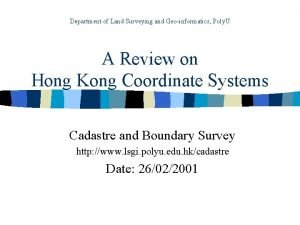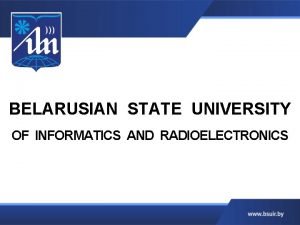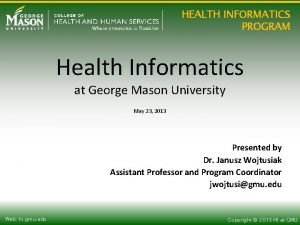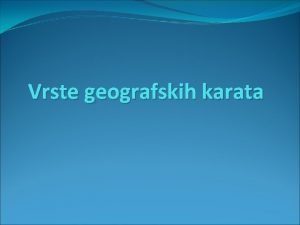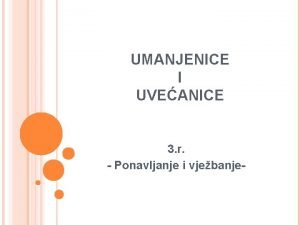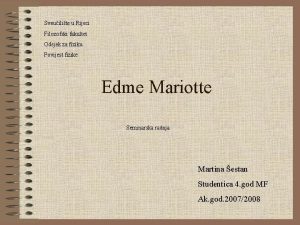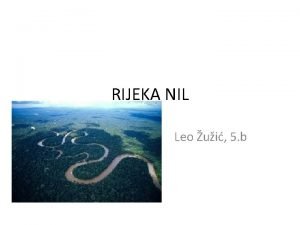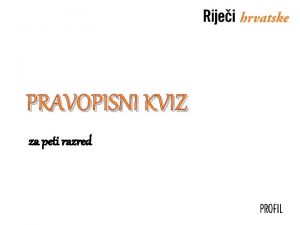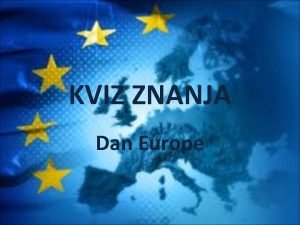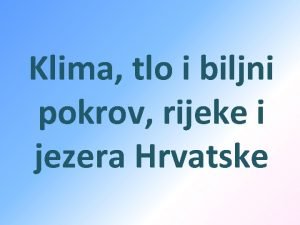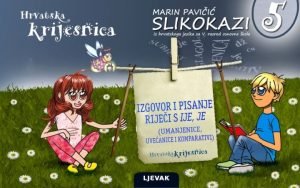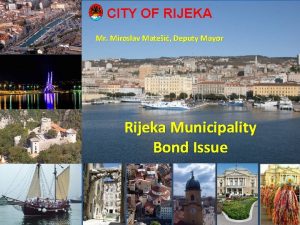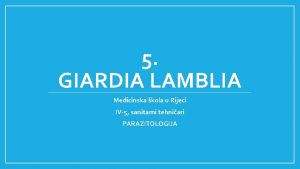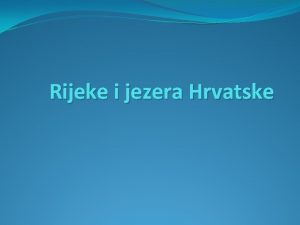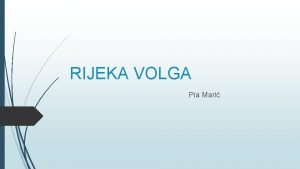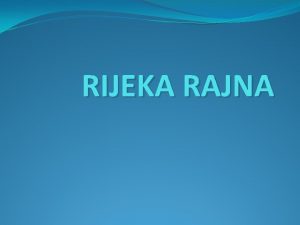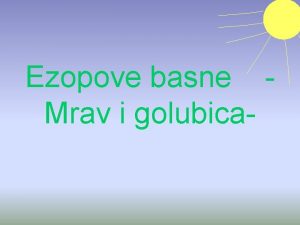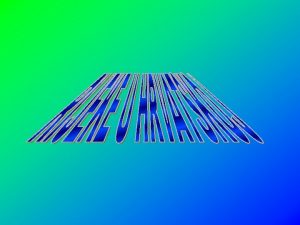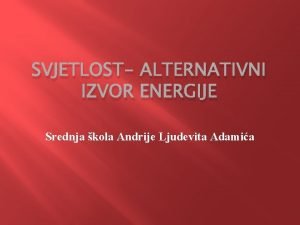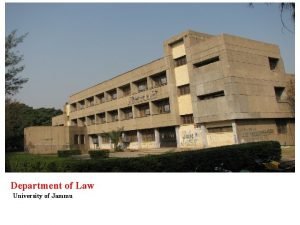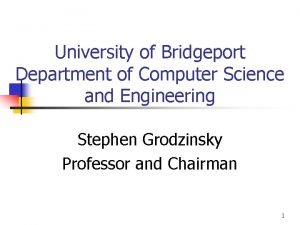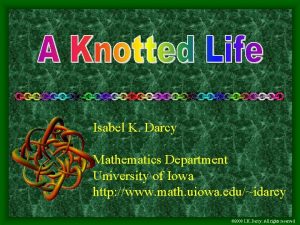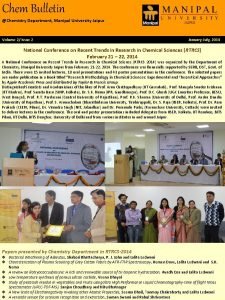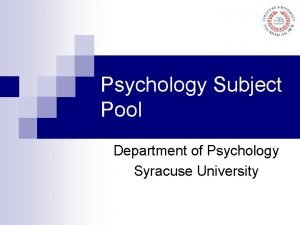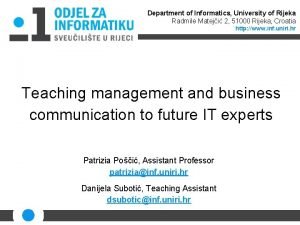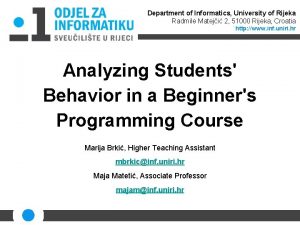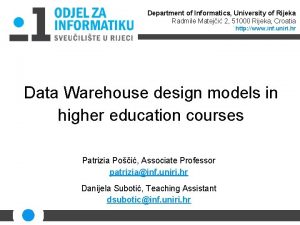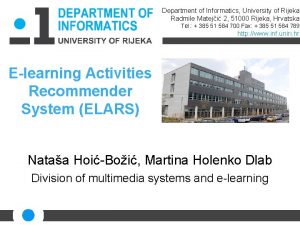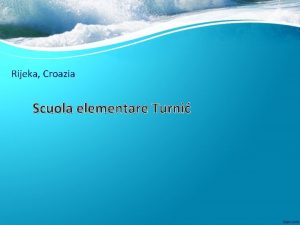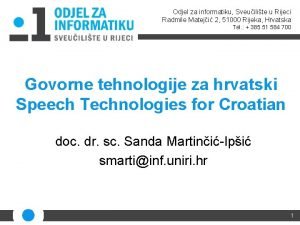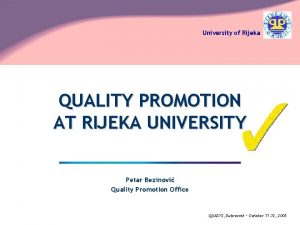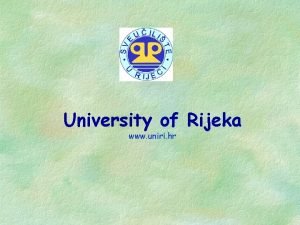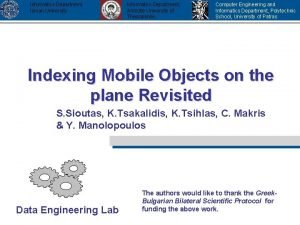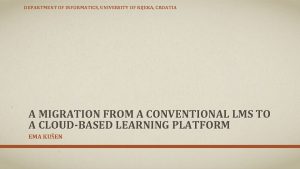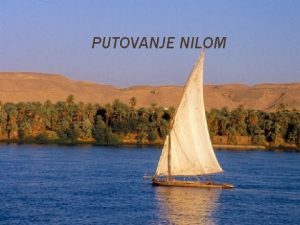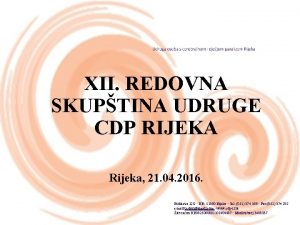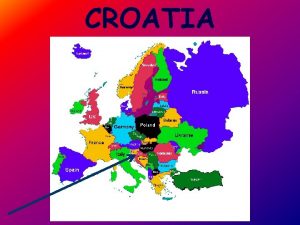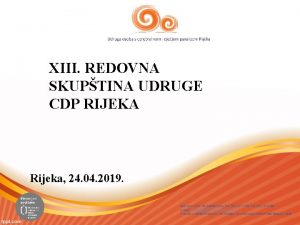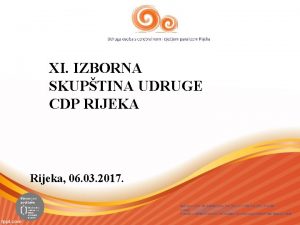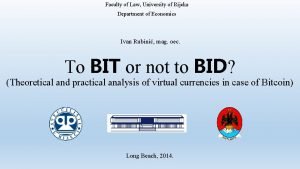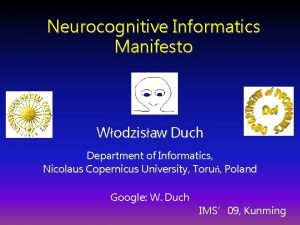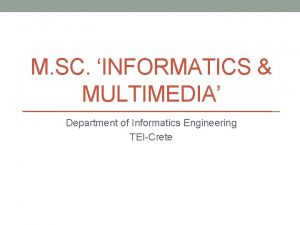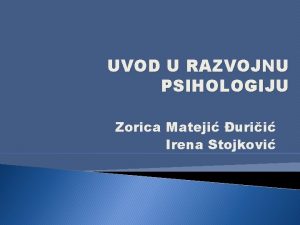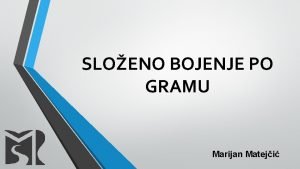Department of Informatics University of Rijeka Radmile Mateji






























- Slides: 30

Department of Informatics, University of Rijeka Radmile Matejčić 2, 51000 Rijeka, Croatia Tel. : + 385 51 584 700 Fax: + 385 51 584 749 SCIENTIFIC COLLABORATION NETWORKS AT THE UNIVERSITY OF RIJEKA Ana Meštrović, Slobodan Beliga, Sanda Martinčić-Ipšić Department of Informatics University of Rijeka 15 th Workshop on “Software Engeneering Education and Reverse Engineering” Bohinj, Slovenia, 23 th-30 th August 2015

Overview • Part I • Complex networks analysis • Part II • Experiment • Results • Conclusion & future work 15 th Workshop on “Software Engineering Education and Reverse Engineering”, Bohinj, Slovenia, 2015 1

Department of Informatics, University of Rijeka Radmile Matejčić 2, 51000 Rijeka, Croatia Tel. : + 385 51 584 700 Fax: + 385 51 584 749 www. langnet. uniri. hr Part I: complex networks

Introduction • Complex networks : graphs (networks) with specific structural properties: • small average path length, • high clustering coefficient, • community structure, • hierarchical structure, • “heavy tail” degree distribution • . . . 15 th Workshop on “Software Engineering Education and Reverse Engineering”, Bohinj, Slovenia, 2015 3

Complex networks: examples • Technological networks • Internet, infrastructure networks, transport networks, power networks, . . . • Social networks • Organisation networks, collaboration networks, (on-line) social networks, epidemic spreading in complex networks, terroristic networks, . . • Information networks • Web, citation networks, semantic networks, language networks, . . . • Biological networks • Metabolic interactions, protein-protein interactions, food chains, . . . 15 th Workshop on “Software Engineering Education and Reverse Engineering”, Bohinj, Slovenia, 2015 4

“Small-world” networks • Universal properties: • small average shortest path length • high clustering coefficient Clustering coefficient of a node is a fraction of links between the neighbouring nodes divided by the all number of links that could possibly exist between them Shortest path length between nodes D and J is 4. Average shortest path length is 2. c=0 c=1/3 15 th Workshop on “Software Engineering Education and Reverse Engineering”, Bohinj, Slovenia, 2015 c=1 5

“Scale free” networks RANDOM NETWORK Number of nodes Majority of nodes have average number of links Small number of nodes deviate SCALE FREE NETWORK Majority of nodes have small Small number of nodes number of links have numer of links an order of magnitude greather than others Number of links 15 th Workshop on “Software Engineering Education and Reverse Engineering”, Bohinj, Slovenia, 2015 6

Macro-scale level analysis: average shortest path length, clustering coefficient, degree distribution, … Meso-scale level analysis: communities detection, Motif analysis, graphlet analysis, . . . Micro-scale level analysis: centrality measures (degree centrality, betweeness centrality, closeness centrality…) 15 th Workshop on “Software Engineering Education and Reverse Engineering”, Bohinj, Slovenia, 2015 7

Macro-scale level analysis • Global network measures: • Average path length, diameter, . . . • Average clustering coefficient, global clustering coefficient, . . . • Density • Average degree, average strength, • Degree distribution, strength distribution, . . . • Assortativity • Modularity • Number of components • . . . 15 th Workshop on “Software Engineering Education and Reverse Engineering”, Bohinj, Slovenia, 2015 8

Meso-scale level analysis • Communities • Motifs • Graphlets 15 th Workshop on “Software Engineering Education and Reverse Engineering”, Bohinj, Slovenia, 2015 9

Micro-scale level analysis • Centrality measures: which node is “the most important”? 15 th Workshop on “Software Engineering Education and Reverse Engineering”, Bohinj, Slovenia, 2015 10

Micro-scale level analysis • Which node is “the most important”? Degree centrality 15 th Workshop on “Software Engineering Education and Reverse Engineering”, Bohinj, Slovenia, 2015 11

Micro-scale level analysis • Which node is “the most important”? Betweenness centrality 15 th Workshop on “Software Engineering Education and Reverse Engineering”, Bohinj, Slovenia, 2015 12

Micro-scale level analysis • Which node is “the most important”? Closeness cenrality 15 th Workshop on “Software Engineering Education and Reverse Engineering”, Bohinj, Slovenia, 2015 13

Micro-scale level analysis • Other centrality measures: eigenvector centrality, Katz centrality, Estrada centrality, percolation centrality, . . . • Page. Rank algorithm, Google, 1998. 15 th Workshop on “Software Engineering Education and Reverse Engineering”, Bohinj, Slovenia, 2015 14

Department of Informatics, University of Rijeka Radmile Matejčić 2, 51000 Rijeka, Croatia Tel. : + 385 51 584 700 Fax: + 385 51 584 749 www. langnet. uniri. hr Part II: Scientific collaboration networks– preliminary results

Scientific collaboration networks • What can we find out about scientific collaboration using the network analysis? • To see intensity of the collaborations and connections between scientists (dense or rare) • To identify communities of scientists • To find who are the influential scientists • To find who are the “bridges” between different communities • To compare the collaboration on various institutions • To measure the quality of collaborations 15 th Workshop on “Software Engineering Education and Reverse Engineering”, Bohinj, Slovenia, 2015 16

Experiment setup • Colecting the data: CROSBI (bib. irb. hr) – Department of Informatics – Department of Mathematics – Department of Biotechnology – Faculty of Humanities and Social Sciences –. . . • Data cleaning • Constructing 5 weighted networks : KOAINF, KOAMAT, KOABIO, KOAFFRI , KOAINT • Network analysis 15 th Workshop on “Software Engineering Education and Reverse Engineering”, Bohinj, Slovenia, 2015 17

Data • bib. irb. hr 15 th Workshop on “Software Engineering Education and Reverse Engineering”, Bohinj, Slovenia, 2015 18

Results KOAINF KOAMAT KOABIO KOAFFRI KOAINT Number of nodes 90 44 182 909 1150 Number of links 177 84 976 2735 3862 Average degree 3, 933 3, 818 10, 725 6, 02 6, 687 Maximal degree 22 9 110 64 110 Average strength 7 6, 227 15, 209 9, 013 9, 974 Average path length 3. 6 1. 485 2. 438 5. 87 5. 583 Diameter 8 3 5 16 16 Clustering coefficient 0, 759 0, 897 0, 797 0, 813 Density 0, 044 0, 089 0, 059 0, 007 0, 006 Modularity 0, 658 0, 796 0, 550 0, 891 0, 892 Number of communities 7 8 11 63 69 Number of components 2 8 5 49 54 15 th Workshop on “Software Engineering Education and Reverse Engineering”, Bohinj, Slovenia, 2015 19

Results • Degree distribution of integral network 15 th Workshop on “Software Engineering Education and Reverse Engineering”, Bohinj, Slovenia, 2015 20

Results 15 th Workshop on “Software Engineering Education and Reverse Engineering”, Bohinj, Slovenia, 2015 21

Collaboration network Department of Informatics 15 th Workshop on “Software Engineering Education and Reverse Engineering”, Bohinj, Slovenia, 2015 22

Collaboration network Department of Mathematics 15 th Workshop on “Software Engineering Education and Reverse Engineering”, Bohinj, Slovenia, 2015 23

Collaboration network Department of Biotechnology 15 th Workshop on “Software Engineering Education and Reverse Engineering”, Bohinj, Slovenia, 2015 24

Collaboration network Faculty of Humanities and Social Sciences 15 th Workshop on “Software Engineering Education and Reverse Engineering”, Bohinj, Slovenia, 2015 25

Collaboration network University of Rijeka 15 th Workshop on “Software Engineering Education and Reverse Engineering”, Bohinj, Slovenia, 2015 26

Centrality measures Node Degree centrality Node Closeness centrality Node Betweenness centrality A 1 213 B 1 11, 7 C 1 77625 A 2 140 B 2 10, 77 C 2 59712 A 3 107 B 3 10, 765 C 3 49505 A 4 101 B 4 10, 765 C 4 47361 A 5 100 B 5 10, 765 C 5 41155 A 6 99 B 6 10, 765 C 6 35369 A 7 95 B 7 10, 76 C 7 30055 A 8 94 B 8 10, 76 C 8 29307 A 9 86 B 9 10, 76 C 9 25555 A 10 86 B 10 10, 757 C 10 25465 15 th Workshop on “Software Engineering Education and Reverse Engineering”, Bohinj, Slovenia, 2015 27

Conclusion and future work • Complex networks analysis have the potential to give insight into the quality of the scientific collaboration. • Future work: • collect data for all constituents at the University of Rijeka • compare scientific collaboration of all constituents • quantify the quality of the collaboration by using complex network measures 15 th Workshop on “Software Engineering Education and Reverse Engineering”, Bohinj, Slovenia, 2015 28

Department of Informatics, University of Rijeka Radmile Matejčić 2, 51000 Rijeka, Croatia Tel. : + 385 51 584 700 Fax: + 385 51 584 749 SCIENTIFIC COLLABORATION NETWORKS AT THE UNIVERSITY OF RIJEKA Ana Meštrović, Slobodan Beliga, Sanda Martinčić-Ipšić Department of Informatics University of Rijeka 15 th Workshop on “Software Engeneering Education and Reverse Engineering” Bohinj, Slovenia, 23 th-30 th August 2015
 Department of land surveying and geo-informatics
Department of land surveying and geo-informatics Belarusian university of informatics and radioelectronics
Belarusian university of informatics and radioelectronics George mason university health informatics
George mason university health informatics Opće karte
Opće karte Uvećanica od kapa
Uvećanica od kapa Fakultet za fiziku rijeka
Fakultet za fiziku rijeka Rijeka nil
Rijeka nil Rijeđi ili rjeđi
Rijeđi ili rjeđi Najveća europska konurbacija
Najveća europska konurbacija Rijeke primorske hrvatske
Rijeke primorske hrvatske Jotacija
Jotacija Rijeka population
Rijeka population Giardoza
Giardoza Crnomorski slijev rijeke
Crnomorski slijev rijeke Pia rijeka
Pia rijeka Najveća europska rijeka
Najveća europska rijeka Mrav sukosan
Mrav sukosan Dnjepar slijev
Dnjepar slijev Srednja škola andrije ljudevita adamića rijeka cijena
Srednja škola andrije ljudevita adamića rijeka cijena Nacinski recenici
Nacinski recenici Department of law university of jammu
Department of law university of jammu Department of geology university of dhaka
Department of geology university of dhaka University of padova psychology department
University of padova psychology department University of bridgeport it department
University of bridgeport it department Iowa state math department
Iowa state math department Sputonik v
Sputonik v Psychology texas state
Psychology texas state Department of information engineering university of padova
Department of information engineering university of padova Information engineering padova
Information engineering padova Manipal university chemistry department
Manipal university chemistry department Syracuse university psychology department
Syracuse university psychology department
